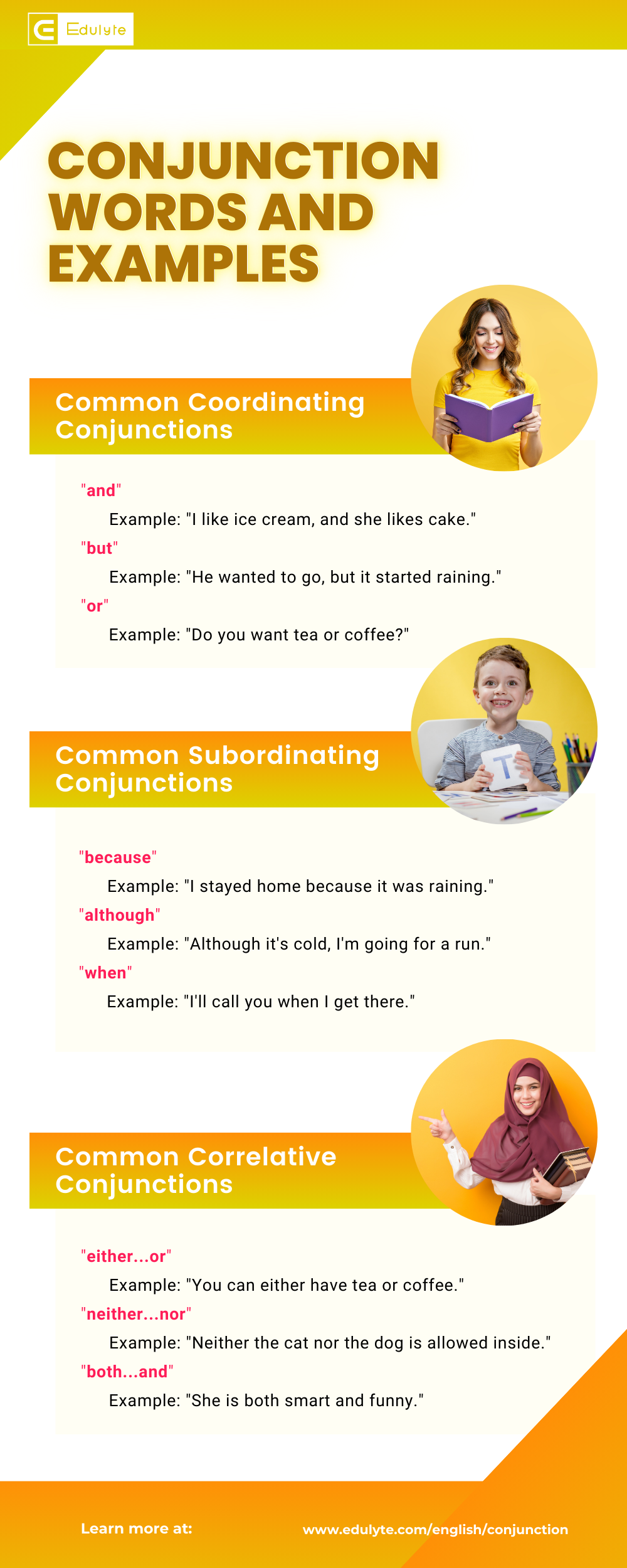
Learn English
Conjunction
Phonetics:
kənˈdʒʌŋkʃn
Pronunciation:
Breaking Down Conjunction in English
Comprehensive Definition, Description, Examples & Rules
What are conjunctions
Conjunction definition includes connecting words, phrases, or clauses to form sentences. They link different parts and express relationships. There are three types of conjunctions: coordinating, subordinating, and correlative conjunctions. They help create clear and cohesive writing.
To define conjunctions, it is important to understand that they play a crucial role in both writing and speaking. They help connect ideas, phrases, and clauses, making our communication more coherent and organized. By using conjunctions effectively, we can express relationships between different parts of our sentences and create a smooth flow of thoughts. Conjunctions in English enhance clarity, improve sentence structure, and enable us to convey complex ideas more effectively. Whether in essays, speeches, or everyday conversations, the importance of define in conjunction lies in their ability to strengthen our communication and make our expressions more impactful.
Types of Conjunctions
Coordinating conjunctions
Coordinating conjunctions meaning are connecting words that join two or more words, phrases, or independent clauses that are of equal importance in a sentence.
Common coordinating conjunctions include “and,” “but,” “or,” “nor,” “for,” “so,” and “yet.” They help create compound sentences, adding variety and clarity to writing and speech.
Here are some coordinating conjunctions examples used in sentences:
- I want to go to the concert, but I don’t have enough money.
- She studies hard, so she gets good grades.
- He likes coffee and tea.
- You can have the burger or the salad.
To use coordinating conjunctions to connect words, phrases, and clauses, you can place them between the items being joined. Coordinating conjunctions are used when two or more ideas are of equal importance and work together to form a complete thought.
Subordinating conjunctions
Subordinating conjunctions are linking words that connect dependent clauses to independent clauses in a sentence. They show the relationship between the two clauses, indicating that one clause is subordinate to the other.
Common subordinating conjunctions include “although,” “because,” “if,” “since,” “when,” and “while.” They help to show the relationship between the dependent clause and the independent clause, and indicate the relative importance of each.
If you’re wondering what is an example of a conjunction, here are some examples of subordinating conjunctions:
- Although it was raining, he still went for a walk.
- Because I studied hard, I passed the exam.
- If you need help, just ask me.
To use subordinating conjunctions, you should first identify the main clause and the idea that you want to subordinate to it. Next, choose an appropriate subordinating conjunction that expresses the relationship you want to convey.
Correlative conjunctions
Correlative conjunctions are pairs of conjunctions that work together to join equal elements in a sentence, such as two nouns, two verbs, or two phrases.
Common correlative conjunctions include “either…or,” “neither…nor,” “both…and,” and “not only…but also.”
Here are some examples of correlative conjunctions, including “not only but also examples”:
- Either John or Sarah will be elected class president.
- Neither the teacher nor the students were happy with the test results.
- Both the book and the movie were entertaining.
To use them correctly, ensure that the sentence elements connected by correlative conjunctions are grammatically parallel and convey the intended meaning.
Conjunctive adverbs
A conjunctive adverb is a type of adverb that connects two independent clauses or sentences. It expresses a relationship between the two clauses, such as contrast, addition, or cause and effect.
Common conjunctive adverbs include “however,” “therefore,” and “meanwhile.” Conjunctive adverbs are usually preceded by a semicolon and followed by a comma.
Here are some examples of conjunctive adverbs:
- John is a great athlete; however, he struggles with math.
- I studied all night; therefore, I aced the test.
- She didn’t have time to finish the project; as a result, she received a lower grade.
To use conjunctive adverbs, place a semicolon after the first independent clause, followed by the adverb and a comma before the second independent clause. This creates a clear and concise connection between the two clauses.
Comparison of Conjunction Types
Coordinating, subordinating, and correlative conjunctions connect sentence elements, while conjunctive adverbs link two independent clauses. Coordinating conjunctions join words, phrases, or clauses, subordinating conjunctions connect a subordinate clause to a main clause, and correlative conjunctions balance or contrast elements. Conjunctive adverbs, such as “however” and “therefore,” are used to join two independent clauses and indicate the relationship between them.
Using coordinating conjunctions can create simple and direct sentences, but it may also result in repetitive writing. Subordinating conjunctions can express complex relationships, but they can also make sentences convoluted. Correlative conjunctions provide balance and contrast, but overusing them can make writing predictable. Effective use of all types of conjunctions is essential for clear and coherent writing.
Conjunction Words and Examples
There are three main types of conjunctions: coordinating conjunctions (e.g. “and,” “but,” “or”), subordinating conjunctions (e.g. “because,” “although,” “while”), and correlative conjunctions (e.g. “either…or,” “neither…nor”). Examples of conjunctions in sentences include “I like both pizza and pasta,” “I studied hard, but I still failed,” and “Either you come with me, or you stay here.”
List of common conjunction words
Here is a conjunction list of conjunction words that can be used to link sentence elements and create smooth and effective communication.
- Coordinating conjunctions: and, but, or, for, nor, yet, so.
- Subordinating conjunctions: although, because, since, if, when, where, while, until, unless, etc.
- Correlative conjunctions: either…or, neither…nor, both…and, not only…but also, whether…or.
Examples of conjunctions in sentences
Here are some conjunction examples used in sentences:
Coordinating conjunctions: “I wanted to go to the beach, but it was raining.”
- Subordinating conjunctions: “Because I was feeling sick, I decided to stay home.”
- Correlative conjunctions: “Neither my sister nor I like mushrooms.”
Using conjunctions to connect words, phrases, and clauses
Conjunctions are used to connect different parts of a sentence, such as words, phrases, and clauses. Here are a few conjunction examples to demonstrate that:
- Coordinating conjunctions: “I like apples, but my sister prefers oranges.”
- Subordinating conjunctions: “After I finish my homework, I’ll go for a walk.”
- Correlative conjunctions: “Either you come with us, or we’ll leave without you.”
Common Mistakes to Avoid
Misusing conjunctions is a common mistake in writing and speaking. One common error is using coordinating conjunctions to connect clauses that are not of equal importance. Another mistake is using subordinating conjunctions incorrectly, resulting in sentence fragments or run-on sentences. To avoid these mistakes, it is essential to understand the functions of different types of conjunctions and use them appropriately.
Common errors with conjunctions include using the wrong type of conjunction, omitting necessary conjunctions, and using too many conjunctions in a sentence. To avoid these errors, it’s important to understand the function of each conjunction and use them appropriately. Also, check for sentence clarity, avoid redundancy, and ensure that each conjunction connects ideas effectively.

Transform Your English Skills
Free sign-up for a personalised dashboard, learning tools, and unlimited possibilities!
Sign up Now
Key Takeaways
- Conjunctions connect words, phrases, or clauses in a sentence.
- There are three types of conjunctions: coordinating, subordinating, and correlative.
- Coordinating conjunctions join elements that are grammatically equal.
- Subordinating conjunctions introduce dependent clauses.
- Correlative conjunctions work in pairs to show balance or contrast.
- Proper use of conjunctions enhances sentence clarity and cohesion.
- Avoid common errors like using the wrong type of conjunction or using too many conjunctions in a sentence.
Quiz
Question comes here
Frequently Asked Questions
Conjunctions connect words, phrases, or clauses in a sentence to form a coherent and organized thought.
Yes, but it is best to use them sparingly at the beginning of a sentence for stylistic reasons.
Use coordinating conjunctions to join two simple sentences or independent clauses, or use subordinating conjunctions to combine a dependent and an independent clause.
Yes, but avoid using too many conjunctions in one sentence as it may affect clarity and readability.
Punctuate each independent clause with a comma before the coordinating conjunction (FANBOYS).
Yes, Edulyte’s worksheet is a useful tool to practice identifying and using conjunctions effectively.


